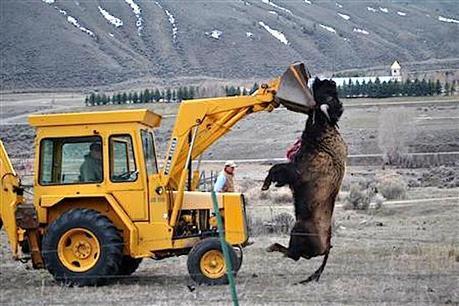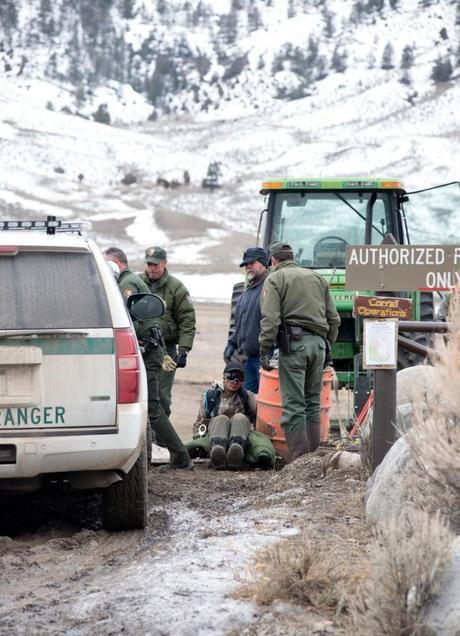
Gardiner Basin
from Earth First! News
Gardiner Basin is the lowest elevation point in Yellowstone National Park—the Boundary Lands ten miles down the Yellowstone River at the confluence of the Gardiner River. If you walk in any direction, you end up in the Rockies. Snow crested Electric Peak and Sepulcher Peaks, towering around 5,000 feet over the basin, mark the formidable southwestern horizon. Due south stands the rugged Black Canyon, and eastward lays the Beartooth Wilderness. A northern journey takes you through Yankee Jim Canyon and Paradise Valley into the Great Plains.
It is through these Boundary Lands of the Gardiner Basin that the bison roam during the Winter season, and it is here that the Stephens Creek bison trap lay open and waiting—until two weeks ago, thanks in no small part to a very special activist. Every year, Bison escaping Yellowstone have been hazed into this area using fearsome tactics including helicopter fly-bys and trucks, which force the bison forward sometimes for more than eight hours at a time with no food or water breaks. They are kept in the trap for days on end, and then transported to slaughterhouses.

In 2008, more than 1,400 bison were “removed” from Montana and slaughtered in a butchery too horrific for words. The mismanagement became so painful that a group of rangers kept more than 150 bison in the Stevens Creek trap to defend them from slaughter, and the entire Yellowstone population from total collapse. That single year cost one third of Yellowstone’s population.
Following public outcry, EarthJustice won a lawsuit to diminish the aggressive hazing and slaughter of the bison, but the ruling was challenged by the Park County Stockgrowers Association, Montana Farm Bureau Federation, and Park County, Montana. In the meantime, the slaughter of the bison continued every ensuing year, including this one—until it was stopped short very recently.
With the EarthJustice lawsuit hanging in the state supreme court, the bison slaughter proceeded. But two weeks ago, amidst the insanity of the bison cull, activist and EF!er Comfrey Jacobs threw down the gauntlet. Twenty-year-old Jacobs is one of those activists who has joined the Buffalo Field Campaign’s roster in order to monitor and record the bison. Having had his fill of the lies and mischief of wildlife management, Jacobs took the trek to Gardiner Basin with a crew from BFC, and handcuffed himself to a barrel full of cement at the access road to the Stevens Creek trap, shutting down all operations for more than two hours.

After Jacobs’s bold move and ensuing public outcry, the wildlife managers stated that they had no more intention to round up bison from Yellowstone. Only days later, the state supreme court ruled in favor of EarthJustice, effectively shutting down the trap and allowing the bison to roam for good—or at least pending further appeal.
We caught up with Jacobs last week, and he broke it down for us about the BFC, the bison, and direct action.
EF!N: First of all, congratulations and thank you for taking direct action. You have shown that an individual can take on a horrifying institutional practice, and stop it in its tracks. What inspired you to take action?
Comfrey: I was feeling kinda helpless watching the governments mismanagement, total decimation, and physical removal of Americas last wild buffalo from the landscape, while I was working with Buffalo Field Campaign trying to get hunters to advocate for year round habitat for buffalo in the greater Yellowstone ecosystem and the state of Montana. I felt that I had hit a dead end with all ‘legal’ methods of advocacy and I just couldn’t sit on sidelines and watch this atrocity go down yet again.
EF!N: Did you expect that you would be able to stop the slaughter for longer than your blockade was up?
C: No, not at all. I went into this action thinking I would just be taking a symbolic stand against the park service and delay transport operations for a few hours, not get them to halt slaughter operations all together for the year, which I’d like to mention was only possible because of the amazing outpouring of love and support for my actions and the buffalo.
EF!N: So now that the Bison slaughter has been called off, how do you feel?
C: I’m absolutely stoked on life. For me taking direct action is always a very liberating experience, but to get out of jail and find out how effective my actions really were was something else entirely. I’m still just blown away by it.
EF!N: How long have you worked with the BFC, and what has that been like?
C: This is my second season out here in beautiful Montucky with the BFC, and it has been incredible in every aspect; we’ve got wonderful folks, an awesome landscape to explore, and amazing wildlife to hangout with and defend. I’m in total love with the bioregion, the campaign, and most of all the buffalo. So y’all can expect to find me up here for years to come.
EF!N: We remember you when you came down to Tucson and volunteered with the Journal at the age of 16. We were thinking, “Wow, this dood’s mom must be really cool.” How’d you get involved in activism, and how has your family supported you in the process?
C: Well I wouldn’t ever say I volunteered with y’all, just came down to visit Cobo. But yea my mommy is cool as fuck, I mean my givin name is Comfrey Biafra. But I found activism through this wonderful thing called punk rock. Then the [Second] Iraq war started round the same time as my tenth birthday, and that was it. I was committed.
Instead of taking me to sports practice after skool, my mom would drop me off at peace rallies, protest, or to cook the weekly Food Not Bombs meal. I’ve been incredibly lucky, and my mommy has always supported me through everything—be it hitchhiking and train hopping, moving into an anarchist collective and working at an infoshop at age 15, going to punk shows or mass mobilizations, to taking direct action and standing up for what i believe in. She’s had my back and I will always have hers!
EF!N: If I’m not mistaken, you’ve also done work with Homes Not Jails in Colorado—how do you make the connection between social justice organizing and Earth First!?
C: For me, drawing the connections between social justice and environmental justice is really easy; clean water to drink, clean air to breath, an unpolluted land base to grow and harvest food from, and a place to live are all basic human rights; but beyond that, they’re all things every living thing on this planet is entitled to. To be honest, I personally think if folks can’t draw those connections themselves they ain’t in it to win it.
EF!N: What are your plans for the future?
C: Well for now I’m going to keep rockin out up here with the buffalo and BFC, take care of all my court shit, try and make it out for the Round River Rondi this year, and whenever I make it back home to the Colorado Plateau, I’ll be jumping right back into the fight against oil shale and tar sands extraction with my friends at Canyon Country Rising Tide, Utah Tar Sands Resistance, and Rednecks Against Resource Extraction
EF!N: Do you have any suggestions for people who look at what just happened, and want to get involved?
C: Just get out there and do something! Come up to Montana, and volunteer with us at BFC. You won’t regret it! Or go work with one of the countless other campaigns and community’s of resistance that are fighting back against this mass ecocide…. Just get off y’all’s asses, and let’s build the world we wanna live in instead of just talking and daydreaming about it
We will have more info about Comfrey’s court case in the next Earth First! Journal, which you can subscribe to by following the links above. Also, while you’re at it, donate to Comfrey’s legal support team here.

